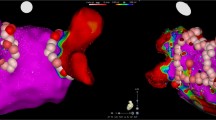Abstract
After atrial fibrillation (AF) develops, the first step is to search for and treat underlying (heart) s. Thereafter, AF should be treated. This includes prevention of cardiovascular morbidity and mortality, especially vascular events, and reduction of symptoms.1 The latter may be obtained by two treatment strategies: rhythm-control and/or rate-control treatment. Recent randomised trials have shown that rate control is not inferior to rhythm control with regard to cardiovascular morbidity and mortality.2 In these studies, predominantly elderly patients with underlying heart s (especially hypertension) were included. Patients with (severely) symptomatic AF and advanced heart failure were excluded. Since then, rate-control treatment has been adopted more frequently, even as first-choice therapy, especially in the elderly.
Similar content being viewed by others
References
Fuster V, Ryden LE, Cannom DS, Crijns HJ, Curtis AB, Ellenbogen KA, et al. ACC/AHA/ESC 2006 Guidelines for the Management of Patients with Atrial Fibrillation: a report of the American College of Cardiology/American Heart Association Task Force on Practice Guidelines and the European Society of Cardiology Committee for Practice Guidelines (Writing Committee to Revise the 2001 Guidelines for the Management of Patients With Atrial Fibrillation): developed in collaboration with the European Heart Rhythm Association and the Heart Rhythm Society. Europace 2006;8:651-745.
Van Gelder IC, Hagens VE, Bosker HA, Kingma JH, Kamp O, Kingma T, et al. A comparison of rate control and rhythm control in patients with recurrent persistent atrial fibrillation. N Engl J Med 2002;347:1834-40.
Healey JS, Toff WD, Lamas GA, Andersen HR, Thorpe KE, Ellenbogen KA, et al. Cardiovascular outcomes with atrial-based pacing compared with ventricular pacing: meta-analysis of randomized trials, using individual patient data. Circulation 2006;114:11-7.
Israel CW, Hugl B, Unterberg C, Lawo T, Kennis I, Hettrick D, et al. Pace-termination and pacing for prevention of atrial tachyarrhythmias: results from a multicenter study with an implantable device for atrial therapy. J Cardiovasc Electrophysiol 2001;12:1121-8.
Carlson MD, Ip J, Messenger J, Beau S, Kalbfleisch S, Gervais P, Cameron DA, et al. A new pacemaker algorithm for the treatment of atrial fibrillation - Results of the Atrial Dynamic Overdrive Pacing Trial (ADOPT). J Am Coll Cardiol 200;42:627-33.
Hemels MEW, Ruiter JH, Molhoek GP, Veeger NJGM, Wiesfeld ACP, Ranchor AV, et al. Right atrial preventive and antitachycardia pacing for prevention of paroxysmal atrial fibrillation in patients without bradycardia: a randomized study. Europace 2008;10:306-13.
Padeletti L, Purerfellner H, Adler SW, Waller TJ, Harvey M, Horvitz L, et al. Combined efficacy of atrial septal lead placement and atrial pacing algorithms for prevention of paroxysmal atrial tachyarrhythmia. J Cardiovasc Electrophysiol 2003;14:1189-95.
Lee MA, Weachter R, Pollak S, Kremers MS, Naik AM, Silverman R, et al. The effect of atrial pacing therapies on atrial tachyarrhythmia burden and frequency: results of a randomized trial in patients with bradycardia and atrial tachyarrhythmias. J Am Coll Cardiol 2003;41:1926-32.
De Voogt WG, Van Hemel NM. Diagnostic tools for atrial tachyarrhythmias in implantable pacemakers. A review of technical options and pitfalls. Neth Heart J 2008;16:201-10.
Hohnloser SH, Capucci A, Fain E, Gold MR, Van Gelder IC, Healey J, et al. Asymptomatic atrial fibrillation and stroke evaluation in pacemaker patients and the atrial fibrillation reduction atrial pacing trial (ASSERT). Am Heart J 2006;152:442-7.
Nowak B, McMeekin J, Knops M, Wille B, Schroder E, Moro C et al. Validation of dual-chamber pacemaker diagnostic data using dual-channel stored electrocardiograms. Pacing Clin Electrophysiol 2005;28:620-9.
De Voogt WG, Van Hemel NM, Van de Bos AA, Koistinen J, Fast JH. Verification of pacemaker automatic mode switching for the detection of atrial fibrillation and atrial tachycardia with Holter recording. Europace 2006;8:950-61.
Author information
Authors and Affiliations
Corresponding author
Additional information
Department of Cardiology, University Medical Center Groningen, University of Groningen, and the Interuniversity Cardiology Institute Netherlands, Utrecht, the Netherlands
Department of Cardiology, University Medical Center Groningen, University of Groningen, the Netherlands
Correspondence to: I.C. van Gelder, Department of Cardiology, Thoraxcenter, University Medical Center Groningen, University of Groningen, PO Box 30.001, 9700 RB Groningen, the Netherlands
Rights and permissions
About this article
Cite this article
van Gelder, I.C., Wiesfeld, A.C.P. Atrial pacing for rhythm control of atrial fibrillation. NHJL 16, 189–190 (2008). https://doi.org/10.1007/BF03086143
Issue Date:
DOI: https://doi.org/10.1007/BF03086143




